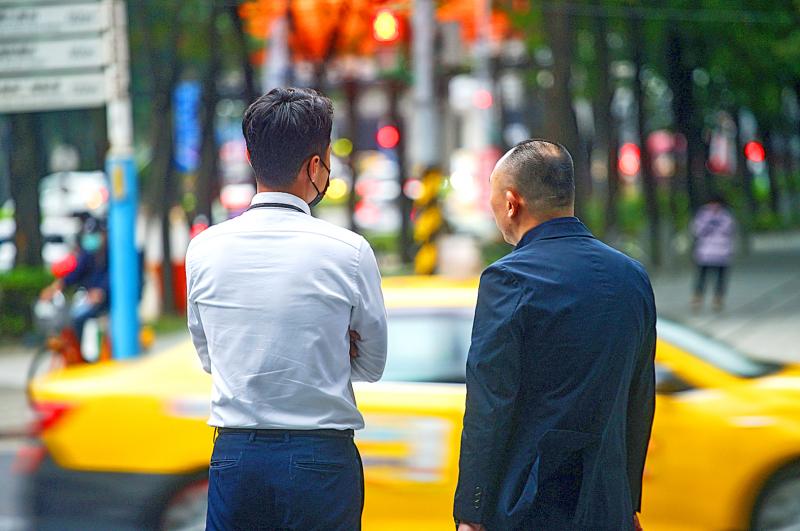The unemployment rate last month dropped to 3.68 percent, falling for the fifth straight month, as fewer people quit or lost their jobs due to business downsizing or closures, the Directorate-General of Budget, Accounting and Statistics (DGBAS) said yesterday.
The latest data showed a decline of 0.07 percentage points from a month earlier as the impact of the COVID-19 pandemic continued to subside, although it has not yet disappeared, the DGBAS said.
“The job market in Taiwan is quite stable, compared with that in other countries in terms of unemployment and labor participation rates,” DGBAS Deputy Director Chen Hui-hsin (陳惠欣) told a media briefing.

Photo: CNA
The labor participation rate softened from a month earlier to 59.14 percent, the data showed.
The jobless reading after seasonal adjustments was 3.76 percent, shrinking 0.01 percentage points from November last year, affirming a stable job market, according to the agency’s monthly report.
The jobless population contracted by about 9,000 people to 440,000 last month as the number of people who lost jobs due to business downsizing or closures dropped by about 4,000, the agency said.
First-time jobseekers declined at a comparable pace, while people who quit decreased by about 1,000, it said.
For the whole of last year, the jobless rate averaged 3.85 percent, gaining 0.12 percentage points from 2019, it said.
Chen blamed the COVID-19 situation for last year’s data, as it diminished consumer activity in the first quarter, pushing the unemployment rate to 4.07 percent in May last year.
The situation started to improve after July, thanks to a boom in domestic tourism and the government’s Triple Stimulus Voucher program after infections were brought under control in Taiwan, she said.
People with university degrees had the highest unemployment rate at 5.48 percent last year, followed by high-school graduates at 3.56 percent and people with graduate degrees at 3.1 percent, the report showed.
People with a junior college education had the lowest unemployment rate at 2.78 percent, followed by people with a junior-high school education at 2.85 percent, it said.
People aged 20 to 24 had the highest unemployment rate at 12.06 percent, followed by the 15-to-19 bracket at 8.18 percent, the 25-to-29 group at 6.5 percent and the 30-to-34 bracket at 3.67 percent, it said.
People aged 45 to 64 had the lowest unemployment rate of 2.3 percent, it said.
There were 4,000 jobs added last year, the poorest performance since the global financial crisis in 2008-2009, Chen said, adding that the pandemic poses continued uncertainty for this year.

STEEP DECLINE: Yesterday’s drop was the third-steepest in its history, the steepest being Monday’s drop in the wake of the tariff announcement on Wednesday last week Taiwanese stocks continued their heavy sell-off yesterday, as concerns over US tariffs and unwinding of leveraged bets weighed on the market. The benchmark TAIEX plunged 1,068.19 points, or 5.79 percent, to 17,391.76, notching the biggest drop among Asian peers as it hit a 15-month low. The decline came even after the government on late Tuesday authorized the NT$500 billion (US$15.2 billion) National Stabilization Fund (國安基金) to step in to buoy the market amid investors’ worries over tariffs imposed by US President Donald Trump. Yesterday’s decline was the third-steepest in its history, trailing only the declines of 2,065.87 points on Monday and

TAKING STOCK: A Taiwanese cookware firm in Vietnam urged customers to assess inventory or place orders early so shipments can reach the US while tariffs are paused Taiwanese businesses in Vietnam are exploring alternatives after the White House imposed a 46 percent import duty on Vietnamese goods, following US President Donald Trump’s announcement of “reciprocal” tariffs on the US’ trading partners. Lo Shih-liang (羅世良), chairman of Brico Industry Co (裕茂工業), a Taiwanese company that manufactures cast iron cookware and stove components in Vietnam, said that more than 40 percent of his business was tied to the US market, describing the constant US policy shifts as an emotional roller coaster. “I work during the day and stay up all night watching the news. I’ve been following US news until 3am

Six years ago, LVMH’s billionaire CEO Bernard Arnault and US President Donald Trump cut the blue ribbon on a factory in rural Texas that would make designer handbags for Louis Vuitton, one of the world’s best-known luxury brands. However, since the high-profile opening, the factory has faced a host of problems limiting production, 11 former Louis Vuitton employees said. The site has consistently ranked among the worst-performing for Louis Vuitton globally, “significantly” underperforming other facilities, said three former Louis Vuitton workers and a senior industry source, who cited internal rankings shared with staff. The plant’s problems — which have not

TARIFF CONCERNS: The chipmaker cited global uncertainty from US tariffs and a weakening economic outlook, but said its Singapore expansion remains on track Vanguard International Semiconductor Corp (世界先進), a foundry service provider specializing in producing power management and display driver chips, yesterday withdrew its full-year revenue projection of moderate growth for this year, as escalating US tariff tensions raised uncertainty and concern about a potential economic recession. The Hsinchu-based chipmaker in February said revenues this year would grow mildly from last year based on improving supply chain inventory levels and market demand. At the time, it also anticipated gradual quarter revenue growth. However, the US’ sweeping tariff policy has upended the industry’s supply chains and weakened economic prospects for the world economy, it said. “Now